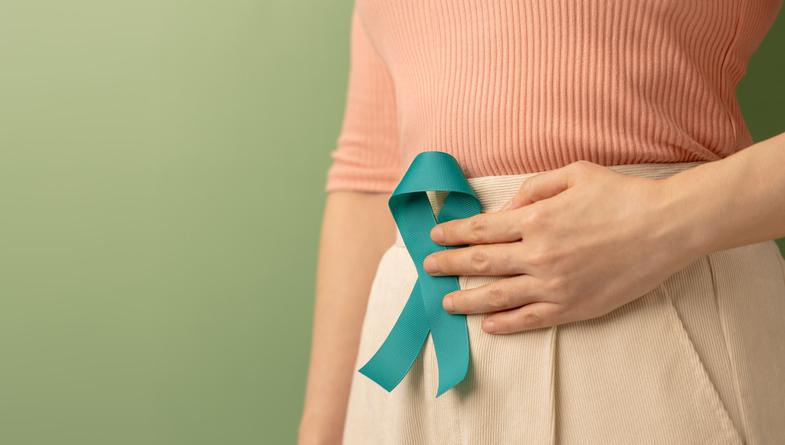
Spotting the signs of ovarian cancer: why acting early matters
Peer reviewed by Dr Colin Tidy, MRCGPAuthored by Victoria RawOriginally published 8 Oct 2025
- TéléchargerTélécharger
- Partager
In the UK, thousands of women are diagnosed with ovarian cancer only after reaching emergency care. Alarmingly, just one in three cases is identified at the earliest stages - when treatment is most effective.
We sat down with Jo Stanford, Health Projects Manager and spokesperson for Ovarian Cancer Action, to discuss why so many women are still diagnosed late, the symptoms that should raise concern, and the steps to take if something doesn’t feel right.
Dans cet article :
Ovarian cancer claims more lives each year than all other gynaecological cancers combined. Yet public awareness of its symptoms remains alarmingly low.
Nearly half of women diagnosed over the past three years first presented as emergency cases, a figure that Ovarian Cancer Action, the UK charity dedicated to improving outcomes for people with the disease, describes not simply as alarming but as a national health crisis.
Poursuivre la lecture ci-dessous
Exploring the causes of late diagnosis
The National Ovarian Cancer Audit’s State of the Nation Report 2025 reveals that nearly half of women with ovarian cancer are only taken seriously once their condition reaches a crisis point - when symptoms become so severe that they require emergency hospital admission.
Jo Stanford, Health Projects Manager, Ovarian Cancer Action, UK, explains that late diagnosis happens for a range of reasons.
Il s'agit notamment de
Difficulties getting timely doctor’s appointments.
Delays within primary or secondary care.
Low awareness of ovarian cancer symptoms.
Being repeatedly dismissed by healthcare providers.
While some of these factors may be out of your control, Stanford emphasises that improving awareness is one crucial area where women can take action - by learning to recognise the symptoms and seeking help early.
“90% of women aren’t aware of the four main symptoms of ovarian cancer,” she says. “And one in four mistakenly believe that a cervical smear test actually detects ovarian cancer, which it does not.
“There is currently no screening test for ovarian cancer, which is why increased awareness of symptoms is absolutely vital.”
What is a CA-125 test?
A CA-125 test measures a protein in your blood that can be higher in ovarian cancer, but also in other non-cancerous conditions such as endometriosis, fibroids, or even menstruation. It can’t diagnose ovarian cancer on its own, so it’s not used for routine screening. Doctors mainly use it to track treatment, check for recurrence, or help assess whether a pelvic mass might be cancerous. You don't have to go private to get a CA-125 test, so it's worth talking to your doctor about having one if your symptoms are being dismissed.
Jo Stanford, Health Projects Manager, Ovarian Cancer Action

What are the four main symptoms of ovarian cancer?
Ovarian cancer symptoms are frequently mistaken for more common health issues, such as irritable bowel syndrome (IBS), menopause, or stress. Because these symptoms are often vague and can overlap with less serious conditions, many women are dismissed by their doctors when they seek help, which can delay diagnosis.
Spotting the signs of ovarian cancer: why acting early matters
Stanford advises that if you regularly have symptoms that could indicate ovarian cancer - even if you don’t have all of them - you should make an appointment with your doctor.
1. Persistent bloating
Persistent bloating can feel like fullness or tightness in your abdomen that doesn’t go away. Your tummy may also look or feel bigger than usual.
Stanford says: “Maybe your clothes feel a bit tighter, or your tummy feels harder than normal. You might notice your tummy is a bit bigger, even if you've lost weight elsewhere, or you may notice a new lump in your tummy.”
2. Difficulty eating or feeling full quickly
You may feel full after only a small amount of food, even when you were hungry beforehand. You might struggle to finish your usual meal and become satiated much sooner than normal.
Stanford says: “It could be that you eat or drink a small amount and already feel full, or notice a loss of appetite compared to usual. You might also experience heartburn, indigestion, or nausea - such as feeling sick, being sick, or just constantly feeling like you’ve got an upset tummy.”
3. Needing to pee more often
Needing to pee more frequently or urgently can be a symptom of ovarian cancer. You may rush to the toilet but pass very little urine, or have the urge to go, even when your bladder is empty.
Stanford says: “You may also feel like you can’t fully empty your bladder.”
4. Pain around your tummy or pelvis
Persistent pain around your tummy - from the middle of your body down to the top of your thighs - should be discussed with your doctor.
Stanford says: “This can be anything from a dull ache, or constant pressure to sharp stabbing pains in your pelvis. It may feel like a heavy dragging sensation, pain that comes and goes but keeps coming back, or pain during sex or when going to the toilet.”
Other potential signs and symptoms of ovarian cancer include:
Back pain - persistent or unusual aches in your lower back.
Indigestion or heartburn - ongoing digestive discomfort, bloating, or nausea.
Abnormal postmenopausal vaginal bleeding - any unexpected bleeding after menopause is a red flag.
Unexplained weight loss - losing weight without trying.
Fatigue - feeling unusually tired despite having enough rest.
“We're not suggesting that every time someone experiences any of these symptoms, they should panic and think it’s ovarian cancer, because it’s most likely not,” says Stanford. “However, it’s really important to acknowledge that we all know our own normal.
“We need to trust women when they notice something out of the ordinary that they've not experienced before. If there's something niggling, we must find the cause of it, rather than ignoring it and assuming it’s something else.”
Poursuivre la lecture ci-dessous
Ovarian Cancer Action's symptoms checker
If you notice any of the above symptoms and are concerned, it’s important to make an appointment with your doctor for a proper check-up. In the meantime, Ovarian Cancer Action has launched a free online symptom checker, available on their website. This quick tool takes around a minute to complete and is designed to help you identify symptoms, recognise patterns, and seek medical advice sooner.
Stanford explains that the checker aims to help people take their health seriously, making sure they don’t ignore symptoms and get them properly checked out.
“Our research shows that many women are more likely to take their dog to the vet than take themselves to the doctor’s,” she says. “We want to empower women to take action and not put their health below that of everyone else.
“Two-thirds of women say they would act immediately if they found a lump in their breast. But fewer than one in four would do the same if they had symptoms of ovarian cancer. Our symptoms checker will help identify these signs and encourage people to act sooner.”
Stanford adds that the Ovarian Cancer Action website’s downloadable symptoms diary is a valuable tool to support discussions with your doctor.
She says: “If you take a written diary documenting your symptoms over time to your appointment, it provides strong evidence to back up your concerns. This makes it less likely that your symptoms will be dismissed and helps your doctor see patterns more clearly.
“We know there can be delays in getting a doctor’s appointment, so keeping a diary in the meantime gives you a way to take proactive steps while you wait.”
The importance of early diagnosis
Detecting ovarian cancer early gives you a 95% chance of survival, while a stage four diagnosis - when the cancer has spread to other parts of your body - carries a survival rate of just 16%.
“If ovarian cancer is caught at an earlier stage, you’re more likely to have treatment,” Stanford explains. “However, less than a third of cases are actually diagnosed at stage 1 or 2.”
She emphasises that, since there is currently no screening test for ovarian cancer, a diagnosis relies entirely on women recognising and reporting their symptoms to their doctor as early as possible.
Stanford adds that ovarian cancer has long been referred to as ‘the silent killer’- a term she believes is misleading and unhelpful. It can give the false impression that the disease has vague or unclear symptoms, which may discourage women from seeking help at crucial stages when early action could save their lives.
“According to the World Ovarian Cancer Coalition, more than 87% of women diagnosed at stage one experienced symptoms,” she says. “Another study found that one in four women who were diagnosed after reporting symptoms were identified at stage one or two. So symptom awareness can therefore translate into higher survival rates.”
Ovarian cancer isn’t just a women’s issue - it’s everyone’s concern
Stanford concludes by emphasising that everyone should be aware of the signs and symptoms of ovarian cancer. Awareness isn’t just important for people with ovaries, but for anyone who might notice symptoms in a friend, family member, or loved one.
“As we've discussed, women aren’t good at going to the doctor because they tend to put everybody else ahead of themselves - especially when it's these niggling symptoms,” she says. “So if you know, love, work with, or care at all about a woman, that little nudge could be the encouragement she needs to make that crucial appointment.”
Patient picks for Gynaecological cancer

Le cancer
Cancer de l'ovaire
Le cancer de l'ovaire est le sixième cancer le plus fréquent chez les femmes au Royaume-Uni. Il est plus fréquent que le cancer du col de l'utérus.
par le Dr Hayley Willacy, FRCGP

Le cancer
Des symptômes de cancer à ne jamais ignorer
Lorsqu'il s'agit de symptômes médicaux inexpliqués, il est facile de faire l'autruche et de les ignorer, surtout s'il est un peu gênant d'en parler. Mais les faire examiner par un médecin pourrait vous sauver la vie. Voici les symptômes du cancer que vous ne devriez jamais ignorer.
par Amberley Davis
Historique de l'article
Les informations contenues dans cette page ont été évaluées par des cliniciens qualifiés.
Next review due: 8 Oct 2028
8 Oct 2025 | Originally published
Auteur: :
Victoria RawExaminé par des pairs
Dr Colin Tidy, MRCGP

Demandez, partagez, connectez-vous.
Parcourez les discussions, posez des questions et partagez vos expériences sur des centaines de sujets liés à la santé.

Vous ne vous sentez pas bien ?
Évaluez gratuitement vos symptômes en ligne